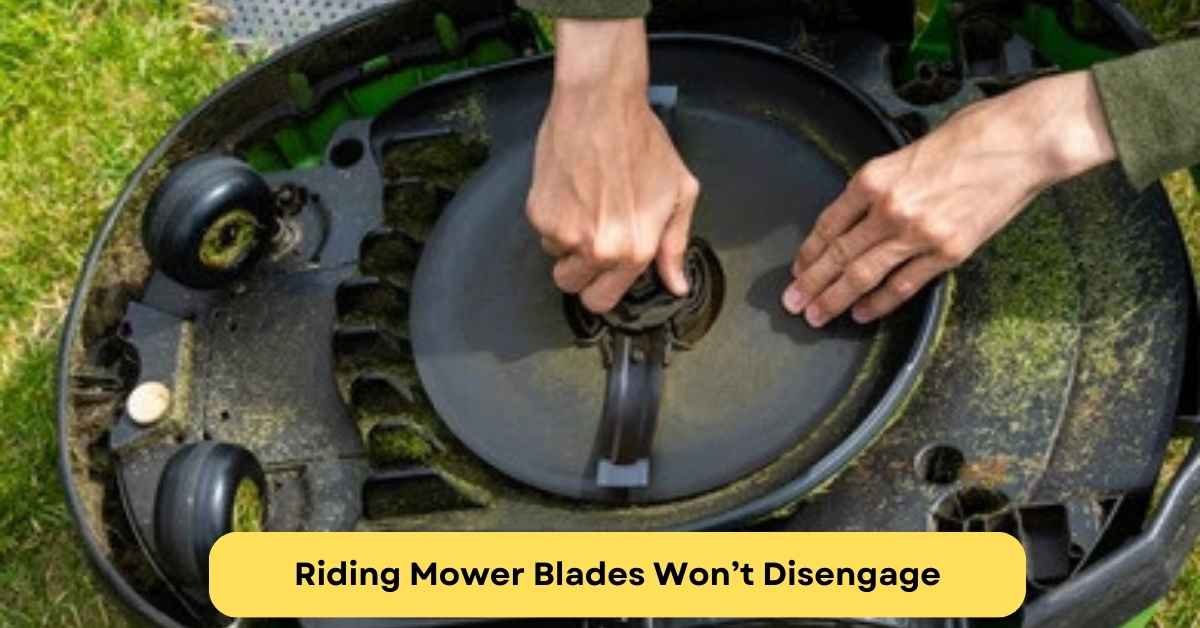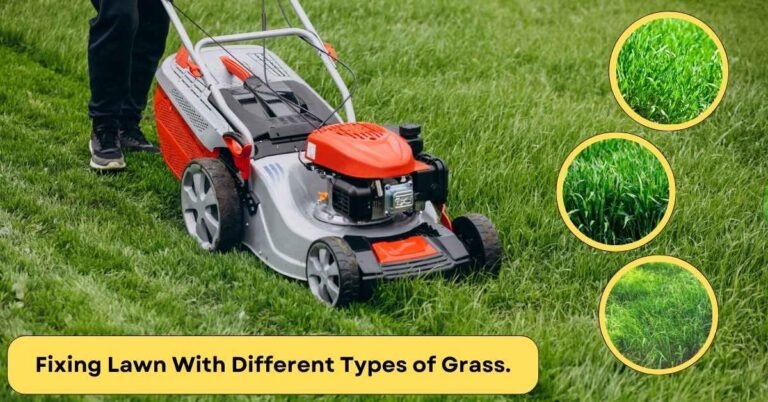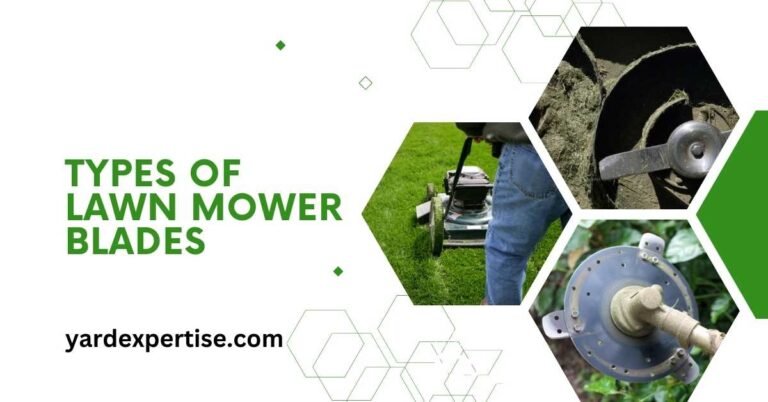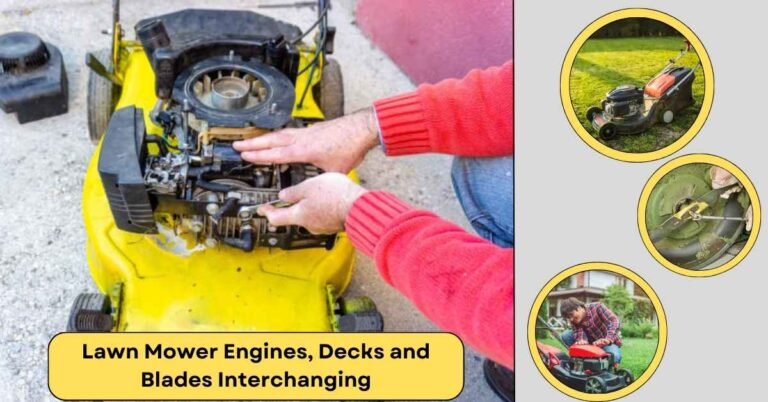Riding Mower Blades Won’t Disengage: How to Stop Blades From Turning?

Riding mowers offer the comfort of sitting on top of your mower while the blades underneath trim your lawn. In between operations, you can keep the engine running but turn off the blades. But you could run into the trouble of your blades not stopping or stopping with delay when you turn them off.
There are several factors to consider while troubleshooting your machine to find out the exact reason that is causing this problem. A lot of delicate parts such as the engagement lever, PTO switch, clutch, safety interlock system, various electrical wirings, and so on perform together to keep your mower active and functional. Damage to these can cause malfunction. Fixing these parts or replacing them with spare parts if necessary will solve your problem.
What Causes Riding Mower Blades Not Disengaging?
Various mechanisms work together to ensure that your mower blades disengage properly when you turn them off. Fault in any of these can result in irregular stoppage of the blades. You can solve this problem with proper guidance and the right tools.
Always follow safety precautions while handling these parts. Wear protective glasses, gloves, masks, and full sleeved shirts while checking under the hood or when you are disassembling the parts.
Loose Engagement Lever
The Blade engagement lever works to pull and push the clutch cable to engage and disengage it. A loose engagement lever means that your blades will not engage or disengage at the desired time. This lever sometimes uses a spring to function and springs wear over time. So check this engagement lever to make sure it is not causing the trouble. Use lubrication on the joints of the lever to make sure it turns properly.
You can buy a spare part if it is severely damaged. Spare engagement levers are cheap and you can buy them for $10-$50.
Faulty PTO (Power Take-Off) Switch
A PTO or Power Take-Off switch is an electronic component that transfers the mower’s mechanical power from the engine to electrical power to other parts. One of these parts that get power from it is the clutch. The clutch is vital to making sure that your blades stop turning slowly after you turn it off.
The blades will not stop turning if they do not get proper connection from the PTO switch. Check if there has been corrosion on the connecting points or if there are any issues with the wiring with the PTO switch. You can buy a spare PTO switch for $20-$30 if the part is beyond repair.
Malfunctioning PTO Clutch
PTO clutch is a round electrical magnet that uses the power from the engine to stop the blades slowly when you turn them off. A faulty PTO clutch will not be able to stop the blades from turning when you stop the blades. Inspect your clutch for faults if your blades do not stop turning.
PTO clutch is the central component that controls how and when your blade stops. So make sure that it is properly engaging and disengaging on command. You can buy a spare PTO clutch for about $100-$250.
Electrical Wiring Issues
There are quite a few delicate electrical wirings inside your lawn mower that take power from the engine and use it for other purposes such as directing power to the clutch. These wirings can be subject to wear and tear or corrosion. Check all the electrical wirings inside the mower with a multimeter to ensure that electricity is flowing without any issues.
Mechanical Obstructions
Dust, debris, and grass can accumulate inside the mechanical components of your mower. This can prevent the clutch from functioning properly and cause the control cables and levers to not engage correctly. Always make sure to keep all the internal parts of your mower tidy.
Mechanical obstructions can also stem from lack of lubrication. Keep all of your moving parts, joints, and central bolt lubricated. Check your motor oil and replace it in a timely manner.
Dry belts, old oil in the machine or the hydraulic system, bent pulleys, and bent blades can also cause issues. Make sure that all of these parts are clean and in their desired condition to avoid mechanical troubles.
Faulty Safety Interlock System
Safety interlock system ensures that your mower engine and blades do not accidentally start. A faulty safety interlock system can keep your blades from stopping at the correct time. Check under the seat to inspect if there is any problem with this part. You can buy a spare safety interlock system for $10-$30.
PTO Belt Problems
The electric PTO clutch system is connected to the blades via a belt. This rubber belt can get dry and cause issues. You need to replace this belt if you hear squealing noises when you turn on or turn off the blades. A spare belt will cost about $10-$20.
Hydraulic System Issues
Hydraulic system uses hydraulic pumps and oil instead of belts, gears, and pulleys to transfer power from the engine to wheels and blades. This system ensures superior performance but comes with the extra hassle of more intensive maintenance.
Hydraulic systems are quite difficult to fix by yourself. You should take it to a certified workshop and get it checked. Depending on the workshop, it will cost you about $250-$500.
Control Cable Problems
Various brands such as Troy-Bilt, Ryobi, MTD, Yard Machines, Bolens, Yard Man, Husky, Briggs & Stratton and so on use control cable instead of engagement levers to stop the blades from turning when you let go of the handle.
This delicate part is prone to wear and tear and might need replacement. You can buy one for about $10-$30.
Ignition Switch or Wiring Problems/ PTO Solenoid Malfunction
Ignition switch starts the mower engine. Ignition switch is an electrical component and thus is subject to corrosion. The solenoids joining the electrical lines are also fragile and prone to damage.
Check all the connections from your ignition switch and PTO switch with a multimeter to confirm that there are no short circuits at any point.
You can buy a spare switch for about $5-$25 if the switch is beyond repair.
Operator Error
Sometimes the fault is not in the machine but the problem lies in the handling. Always make sure that you properly read the instructions manual thoroughly before starting the mower.
Make sure that you are using the gears and PTO switches properly when you start and turn off the mower and the blades. Follow all the safety procedures written on the manual.
How to Get Blades to Stop Turning When Disengaged?
Turn off the engine and put the mower in parking gear if the blades do not stop turning even after turning the blades off. Fix the engagement lever and the control cables and check if they are now contacting properly with the blades.
Check the safety interlock system to see if it is engaging and disengaging properly. Check the engagement levers, control cables, clutch, PTO switch, and other electrical wirings if the problem is still not solved.
Do not try to engage the control cable or the engagement lever while your machine is running. Let the blades completely stop after shutting down the engines before further inspection. Do not immediately check the parts after running the machine as they can get quite hot.
The problem is severe if none of these solutions work and it will require professional care. Take the mower to a workshop and check the clutch and the hydraulic mechanism. Workshops will charge somewhere between $250-$500 for full checkup. Part replacements will cost more depending on the price of the respective parts.
How to engage and disengage riding mower blades safely?
Irregular stoppage of mower blades can result in uneven cut grass or the blades can hit hard objects accidentally. Follow the instruction manuals that were provided with your lawn mower to safely engage and disengage the riding mower blades. Learn to operate the PTO switch properly if they require it to operate.
Learn to operate the gearbox properly. Do not try to force the gearbox to move without adequately engaging the clutch.
How to Maintain and Check Riding Mower Blades Regularly?
Your riding mower blades perform the heavy duty of chopping and trimming grasses. Oftentimes it will hit rock, debris, dust and plastic and metal junk. The blades are also prone to rusting as time moves forward. Regular maintenance of the blades is vital to ensuring longevity of your mower.
Tilt the mower with the air filter facing up and loosen the central bolts holding the mower blades with a suitable wrench. Then carefully take off the blades and store all the screws in a secure place.
Clean the blades with a wire brush and cloth. Sharpen the blades with a file, an angle grinder, or a bench grinder if the sharpness is not up to your liking. Make sure that both sides of the blades are balanced properly.
Clean under the deck of your mower where the blades rotate. Dust or junk accumulation in these parts will cause the blades to function improperly.
So follow these simple procedures and do not let the blades run after turning off the connection to avoid accidental cuts and trims of grass preserving the aesthetics of your yard with a clean and fresh trim.





